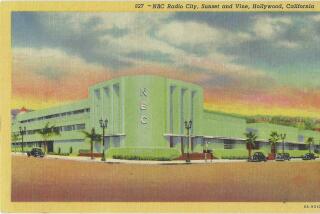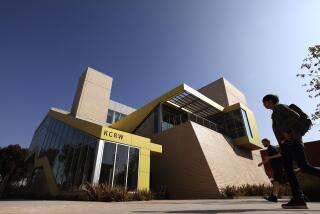Waltz Ends at KFAC as New Crew Gears Up for Rock Format
Today the half-century old tradition that is KFAC-FM (92.3) dies. In its place will be a contemporary-hits radio station that will debut with a $2-million advertising blitz announcing its entry into the crowded field of rock stations.
Musical selections by such venerable composers as Strauss, Shostakovich and Haydn will give way to danceable tunes by Paula Abdul, Fine Young Cannibals and the Rolling Stones. (Station officials won’t say exactly when the format will change, but indications are there could be a sizable time gap between the formats.) At the brick KFAC building, tucked-away in the foothills of Hollywood, a party will mark the passing of KFAC--Los Angeles’ only commercial classical music station--and the birth of KKBT in its place.
KFAC will play its last piece--Franz Joseph Haydn’s Farewell Symphony--shortly after noon, with KFAC veterans on hand as well as KUSC-FM personnel, to whom a symbolic baton will be handed over. KFAC, which will simulcast its last classical hour between noon and 1 p.m. today with KUSC-FM (91.5), has been running announcements telling listeners to tune in to public-radio station KUSC for classical programming.
KFAC has donated some of its library to KUSC and will present the station with a $35,000 check. Several of KFAC’s programs have gone over to KUSC, such as the broadcast season of the Philadelphia Orchestra, but the fate of the popular Texaco-sponsored Metropolitan Opera broadcasts, which begins in December, is still up in the air.
About half of KFAC’s office staff--but none of the announcers or the music director or program director--will stay on at the new station, said station general manager Jim de Castro.
KFAC’s classical collection of 55,000 recordings is gone (having been donated to the Stanford University Music Archives, the Los Angeles Public Library and KUSC) and in its place are brand-new production studios and a library of about 3,000 contemporary albums and compact discs, according to assistant program director Frank Miniacci.
After months of research and testing, the company that owns KFAC, Evergreen Media Corp., decided that the new format will be targeted to an audience of ages 25-44, 60% females, 40% males, with music and on-air talent selected to attract the “demographic and psychographic makeup” of Los Angeles. De Castro said those demographics include 58% white, 24.7% Latino, 9.7% Asian and 7.5% black, with expected increases in the Latino and Asian populations.
“All of a sudden this glaring thing smacks us in the face and says, ‘You better attract Hispanics,’ ” De Castro said. “But we don’t want to attract too many Hispanics. We want to attract 33%. . . .”
Station officials say that comedian Paul Rodriguez will form the cornerstone of the morning drive team on the station and that he will broadcast live from various spots around Southern California. The playlist will include 60% rock oldies (songs from the mid-’60s to the late ‘80s) and 40% contemporary hits. Some of the artists the station plans to play include George Michael, Steve Winwood, the Supremes, Miami Sound Machine and Luther Vandross.
“Our station will have a very urban flavor,” De Castro said.
Like the most recent rock station to hit the airwaves, KQLZ or “Pirate Radio,” KKBT plans to hit the market amid a promotion and advertising blitz. De Castro said he plans to spend about $2 million between now and January on commercials, billboards and other advertisements.
First to announce the new station--dubbed FM-92--is a billboard that will go up today at Highland and Franklin avenues, supplanting, ironically enough, a billboard for Pirate Radio, which since its debut in March has climbed to No. 3 in the Arbitron ratings.
But, said De Castro, the former general manager of WLUP, the No. 1 station in Chicago, “We’re not going to overpower people like Pirate. We’re spending a lot of money but it’s going to be different the way we spend it. . . . We’re going to demonstrate through our actions how hip it is to listen to our station.”
As part of the promotional efforts, several KFAC landmarks will be replaced by the signposts of the latest in popular culture. A mural painted in 1983 and covering one of the outer walls of the station, which depicts such composers as Bach, Verdi and Mozart mingling in a production studio with former KFAC personnel like Carl Princi, Tom Franklin and Fred Crane, will soon be replaced by new artwork which will feature Madonna, James Dean, Frank Sinatra and Marilyn Monroe in a restaurant-bar setting recalling the building’s origins as the Villa Capri restaurant.
Another feature at KFAC, the Wall of Fame--a series of brass plaques bearing the names of such luminaries as Vladimir Horowitz, Jascha Heifetz and Sir Neville Mariner--will soon be joined by a new succession of plaques featuring the names of rockers Mick Jagger, Bruce Springsteen and Elton John, De Castro said.
The demise of KFAC, which has been rumored since the station was purchased in January for $55 million by Evergreen Media Corp., has angered and saddened longtime listeners and much of the classical music community.
De Castro expected that there would be an organized effort to fight the format change, but none has materialized so far.
Although acknowledging that the station has been flooded with letters and phone calls protesting the dropping of the classical format, De Castro said: “I’m shocked that there weren’t groups and pickets.”
Harvey S. Frey, one of several who tried to organize efforts to stop the change in format, said he received almost 300 letters and calls after The Times published his letter asking for support to fight the changeover.
He formed a nonprofit corporation, Committee for Classical Music, Inc., and has encouraged KFAC listeners to lobby KUSC to increase its classical programming and to persuade KKGO-FM (105.1) owner Saul Levine to expand the hours the station plays classical music. (On Monday, the jazz station began devoting four morning hours and four evening hours to classical music.)
“KFAC, with all its faults, has meant so much to so many of us for so many years that the grief over its loss is almost like that over the loss of a family member,” Frey wrote.
More to Read
The biggest entertainment stories
Get our big stories about Hollywood, film, television, music, arts, culture and more right in your inbox as soon as they publish.
You may occasionally receive promotional content from the Los Angeles Times.










